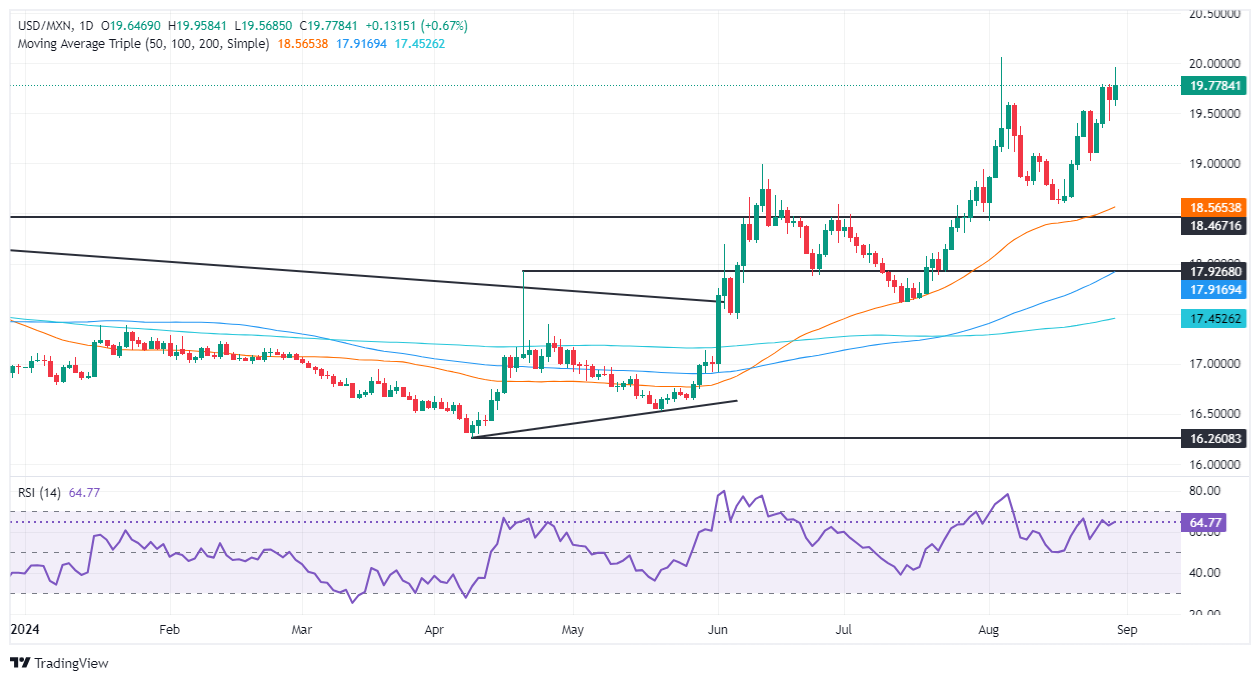- Mexican Peso declines as Banxico cuts 2024, 2025 GDP forecast.
- Political unrest over judiciary reform and dismantling of autonomous bodies further pressures the Peso.
- Banxico sees inflation reaching 3% target by late 2025, with growth risks skewed downward due to slowing US economy.
The Mexican Peso depreciated against the Greenback on Thursday, with the latter extending its gains for the second straight day on robust US data. Meanwhile, the emerging market currency dropped after the Bank of Mexico (Banxico) revised Mexico’s growth expectations to the downside for the rest of 2024, according to its quarterly report. The USD/MXN trades at 19.77 and gains over 0.70%.
Mexico’s political turmoil continues to dampen the prospects of the Mexican currency. President-elect Claudia Sheinbaum reassured foreign investors that their investments are secure, even though she approves the judiciary reform and the bill for the dissolution of autonomous bodies pushed by President Andres Manuel Lopez Obrador.
In addition, Banxico downwardly revised the Gross Domestic Product (GDP) for 2024 from 2.4% to 1.5% and from 1.5% to 1.2% for 2025 after revealing its Q2 2024 quarterly revision.
In the report, policymakers mentioned that “national economic activity is going through a period of market weakness and uncertainty.” They revisited inflation expectations higher and expect it to hit the bank’s 3% goal toward the end of 2025.
Furthermore, they added that risks to growth are tilted to the downside, adding that an economic deceleration in the US economy weighs on Mexico’s economic outlook.
Banxico Governor Victoria Rodriguez Ceja warned that adjustments to the main reference rates would be gradual only when macroeconomic conditions allowed them.
Across the border, the US Bureau of Economic Analysis (BEA) upwardly revised the second estimate for Gross Domestic Product (GDP). At the same time, the US Department of Labor revealed that the number of Americans filing for unemployment benefits dipped.
Daily digest market movers: Mexican Peso collapses as AMLO pauses relations with US-Canada ambassadors
- Mexican President Andres Manuel Lopez Obrador's decision to pause relations with the US and Canadian ambassadors this wee will continue to weigh on the Mexican Peso.
- Comments from US Ambassador Ken Salazar, expressed on August 22, were the reason behind AMLO’s decision. Salazar said that the judiciary reform threatens the rule of law and added that “the direct election of judges represents a major risk to the functioning of Mexico’s democracy. Any judicial reform must have safeguards that guarantee that the judiciary is strengthened and not subject to the corruption of politics.”
- US GDP for Q2 2024 saw a second estimate that jumped from 1.4% in Q1 to 3%, exceeding estimates of 2.8%. The Personal Consumption Price Expenditures (PCE) Deflator hinted that inflation dipped from 3.1% to 2.5% QoQ, slightly higher than the 2.3% foreseen.
- Initial Jobless Claims for the week ending August 24 dipped from 233K to 231K, below estimates of 232K.
- Traders will eye Fed speakers and the Fed’s preferred inflation gauge, the core Personal Consumption Expenditures Price Index (PCE), which arrives on Friday.
- Data from the Chicago Board of Trade (CBOT) suggests the Fed will cut at least 98 basis points (bps), according to the fed funds rate futures contract for December 2024.
Technical outlook: Mexican Peso slumps as USD/MXN hits two-week high at 19.95
The USD/MXN is at the risk of decisively clearing the 20.00 hurdle. From a technical standpoint, the uptrend remains intact as the Peso, although it has achieved some positive days, continues to register more significant losses.
The Relative Strength Index (RSI) suggests that buyers are in charge. The RSI is still bullish but not in overbought territory.
Therefore, the path of least resistance is to the upside. The USD/MXN first resistance would be 20.00. A breach of that level will expose the year-to-date (YTD) high at 20.22, followed by the September 28, 2022, daily high at 20.57. If those two levels are surrendered, the next stop would be the August 2, 2022, swing high at 20.82, ahead of 21.00.
Conversely, if USD/MXN tumbles below 19.50, this would expose the 19.00 figure. Further losses lie beneath that level, opening the door to test the August 19 low of 18.59, followed by the 50-day Simple Moving Average (SMA) at 18.48.
Mexican Peso FAQs
The Mexican Peso (MXN) is the most traded currency among its Latin American peers. Its value is broadly determined by the performance of the Mexican economy, the country’s central bank’s policy, the amount of foreign investment in the country and even the levels of remittances sent by Mexicans who live abroad, particularly in the United States. Geopolitical trends can also move MXN: for example, the process of nearshoring – or the decision by some firms to relocate manufacturing capacity and supply chains closer to their home countries – is also seen as a catalyst for the Mexican currency as the country is considered a key manufacturing hub in the American continent. Another catalyst for MXN is Oil prices as Mexico is a key exporter of the commodity.
The main objective of Mexico’s central bank, also known as Banxico, is to maintain inflation at low and stable levels (at or close to its target of 3%, the midpoint in a tolerance band of between 2% and 4%). To this end, the bank sets an appropriate level of interest rates. When inflation is too high, Banxico will attempt to tame it by raising interest rates, making it more expensive for households and businesses to borrow money, thus cooling demand and the overall economy. Higher interest rates are generally positive for the Mexican Peso (MXN) as they lead to higher yields, making the country a more attractive place for investors. On the contrary, lower interest rates tend to weaken MXN.
Macroeconomic data releases are key to assess the state of the economy and can have an impact on the Mexican Peso (MXN) valuation. A strong Mexican economy, based on high economic growth, low unemployment and high confidence is good for MXN. Not only does it attract more foreign investment but it may encourage the Bank of Mexico (Banxico) to increase interest rates, particularly if this strength comes together with elevated inflation. However, if economic data is weak, MXN is likely to depreciate.
As an emerging-market currency, the Mexican Peso (MXN) tends to strive during risk-on periods, or when investors perceive that broader market risks are low and thus are eager to engage with investments that carry a higher risk. Conversely, MXN tends to weaken at times of market turbulence or economic uncertainty as investors tend to sell higher-risk assets and flee to the more-stable safe havens.
Information on these pages contains forward-looking statements that involve risks and uncertainties. Markets and instruments profiled on this page are for informational purposes only and should not in any way come across as a recommendation to buy or sell in these assets. You should do your own thorough research before making any investment decisions. FXStreet does not in any way guarantee that this information is free from mistakes, errors, or material misstatements. It also does not guarantee that this information is of a timely nature. Investing in Open Markets involves a great deal of risk, including the loss of all or a portion of your investment, as well as emotional distress. All risks, losses and costs associated with investing, including total loss of principal, are your responsibility. The views and opinions expressed in this article are those of the authors and do not necessarily reflect the official policy or position of FXStreet nor its advertisers. The author will not be held responsible for information that is found at the end of links posted on this page.
If not otherwise explicitly mentioned in the body of the article, at the time of writing, the author has no position in any stock mentioned in this article and no business relationship with any company mentioned. The author has not received compensation for writing this article, other than from FXStreet.
FXStreet and the author do not provide personalized recommendations. The author makes no representations as to the accuracy, completeness, or suitability of this information. FXStreet and the author will not be liable for any errors, omissions or any losses, injuries or damages arising from this information and its display or use. Errors and omissions excepted.
The author and FXStreet are not registered investment advisors and nothing in this article is intended to be investment advice.
Recommended content
Editors’ Picks

EUR/USD drops to two-year lows below 1.0400 after weak PMI data
EUR/USD stays under bearish pressure and trades at its weakest level in nearly two years below 1.0400. The data from Germany and the Eurozone showed that the business activity in the private sector contracted in early November, weighing on the Euro.

GBP/USD falls to six-month lows below 1.2600, eyes on key data releases
GBP/USD extends its losses for the third successive session and trades at a fresh fix-month low below 1.2600. This downside is attributed to the stronger US Dollar (USD) as traders continue to evaluate the Fed's policy outlook following latest data releases and Fedspeak.

Gold price refreshes two-week high, looks to build on momentum beyond $2,700 mark
Gold price hits a fresh two-week top during the first half of the European session on Friday, with bulls now looking to build on the momentum further beyond the $2,700 mark. This marks the fifth successive day of a positive move and is fueled by the global flight to safety amid persistent geopolitical tensions stemming from the intensifying Russia-Ukraine war.

Ripple surges to a new yearly high; XRP bulls aim for three-year high of $1.96
Ripple extends its gains by around 10% on Friday, reaching a new year-to-date high of $1.43 and hitting levels not seen since mid-May 2021. The main reasons behind the rally are the announcement that the US SEC's Chair Gary Gensler will resign and the launch in Europe of an XRP ETP by asset management company WisdomTree.

A new horizon: The economic outlook in a new leadership and policy era
The economic aftershocks of the COVID pandemic, which have dominated the economic landscape over the past few years, are steadily dissipating. These pandemic-induced economic effects are set to be largely supplanted by economic policy changes that are on the horizon in the United States.

Best Forex Brokers with Low Spreads
VERIFIED Low spreads are crucial for reducing trading costs. Explore top Forex brokers offering competitive spreads and high leverage. Compare options for EUR/USD, GBP/USD, USD/JPY, and Gold.
